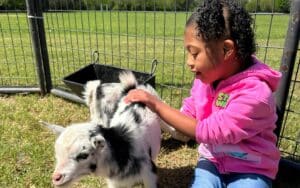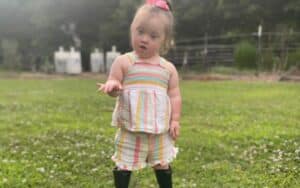Every child’s ability to communicate and express themselves grows from their earliest experiences from the words, sights, sounds, and gestures they are exposed to. By cultivating a language-rich home environment, parents can offer their child a strong foundation for speech, language, communication, academics, social interactions, and the workplace. This article offers insights into twenty of the many ways to create a language-rich home environment for your child.
1. Regular Conversations: Talking & Listening
- Example: Respond to and repeat your baby’s coos and babbling.
- Example: Discuss your activities throughout the day.
- Example: Ask open-ended questions. Ask and answer your own questions if you child does not respond.
2. Narration: Describing Your Actions
- Example: Detail your cooking process: “I’m slicing the carrots.”
- Example: Describe your surroundings during a walk.
- Example: Talk through the process of fixing something around the house.
3. Daily Reading Habit
- Example: Share developmentally and interest appropriate picture books, short stories, novels, science and history books, magazines, and more.
- Example: Read books and environmental print aloud. In books, discuss illustrations, actions, and characters.
- Example: Schedule regular library and bookstore visits to discover and explore new books.

4. Modeling: Show, Don’t Just Tell
- Example: Express emotions and their reasons: “I’m happy because the sun is shining.”
- Example: Share ideas in understandable chunks.
- Example: Highlight the importance of information by pointing.
5. Imitation: Imitation as a Teaching Tool
- Example: Play games like ‘Echo’ where you take turns imitating each other’s sounds and words.
- Example: Recite rhymes or song lyrics together.
- Example: Mirror body language during storytelling.
6. Instruction: Step-by-Step Guidance
- Example: Break down the process of making a sandwich.
- Example: Discuss stages of daily routines such as getting ready in the morning.
- Example: Describe the sequence of events in a movie or book.
7. Embrace Repetition and Spaced Repetition
- Example: Revisit the same story multiple times, discussing old and new elements.
- Example: Regularly review and discuss previously learned vocabulary in various contexts.
- Example: Sing familiar songs with repeated verses.
8. Access to Developmentally Appropriate Books
- Example: Use colorful board books and tactile books with textures for toddlers.
- Example: Introduce simple story books to pre-readers and budding readers.
- Example: Offer chapter books, magazines, and current event articles to readers.
9. Empower Through Choices
- Example: Ask whether child would prefer a story or a song before bed. Show the options.
- Example: Offer and show two book options for reading time.
- Example: Let the child choose their preferred option snack, clothing, music, television, etc. Use visuals paired with words whenever possible.
10. Organized Play Environment
- Example: Dedicate specific areas for reading and art.
- Example: Set up zones for imaginative play, like a ‘post office’ or ‘kitchen’.
- Example: Organize like toys and books together and regularly rotate and refresh available toys and books.
11. Offer Open-Ended Art Experiences
- Example: Storytelling puppets for narrative skill enhancement and vocabulary expansion.
- Example: Nature collages to discuss textures, colors, and shapes, improving descriptive language.
- Example: Playdough shaping activities to boost creativity, imitation, turn taking, and vocabulary development.

12. Multi-Sensory Hands-On Play
- Example: Safely engage in messy play with substances like water, paint, or playdough.
- Example: Explore different sounds with various types of music, musical instruments, household items that make sounds, and nature.
- Example: Encourage safe tactile exploration with nature materials, like leaves or rocks.
13. Toy Rotation to Maintain Interest
- Example: Introduce ‘new’ old toys from a stored collection.
- Example: Theme-based rotation: from a ‘space week’ to a ‘jungle week’.
- Example: Group and display toys based on color, common properties, or function.
14. Environmental Labeling for Recognition
- Example: Label toys and important household items with easily readable tags.
- Example: Use images and words for younger children.
- Example: For older children, include descriptive or additional information.
15. Integrate Language into Daily Tasks
- Example: Count objects during cleanup.
- Example: Describe ingredients and their flavors during meal prep.
- Example: Name colors and patterns while getting dressed.
16. Encourage Sharing Stories
- Example: Model and encourage tales about the child’s experiences and favorite toys’ adventures.
- Example: Share family history, events, or ancestral stories.
- Example: Narrate your personal experiences, adapting them as stories.
17. Offer Structured Choices to Prompt Discussion
- Example: “Would you prefer the blue cup or the red one?”
- Example: “Which park should we visit: the big one or the one with the pond?”
- Example: “For art, would you like to paint or color today?”

18. Curate Open-Ended Toys
- Example: Offer toys such as dolls, action figures, dollhouses, or train sets for imaginative play.
- Example: Create art from versatile (and safe) art materials: colored papers, beads, feathers.
- Example: Play board games that allow for varying narratives and strategies.

19. Promote Exploration of the Surroundings
- Example: Nature treks, discussing and photographing what you see and experience.
- Example: Museum visits, followed by a review of photos and discussion about the experience.
- Example: Cultural festivals or events to introduce new traditions and languages.
20. Use Routine Moments for Vocabulary Building
- Example: Describe sensations while bathing: “The water feels warm.”
- Example: Use a calendar and discuss the weather, day of the week, and planned activities (could also use a daily schedule) each morning.
- Example: Name and discuss tools and methods during house chores.
FAQs:
1. When should I begin implementing language learning strategies?
Begin on day one! Even newborns benefit from hearing and experiencing language.
2. How do I adapt these techniques for older children?
Engage in more complex activities and conversations, offer more advanced reading materials, and discuss subjects like current events, favorite food or music artists, sports, scientific concepts, and other special interests.
3. What if my child isn’t responsive to a particular strategy?
Every child is unique. If one strategy isn’t effective, modify it or try another. Always be mindful of your child’s current attention, developmental level, interests, and pace.
4. How can technology be incorporated without hindering language development?
Use technology as a tool. Interactive language apps, e-books, and educational videos can be beneficial. But remember, nothing replaces the value of face-to-face interaction.
5. How can bilingual or multilingual households enhance a language-rich environment?
Celebrate each language! Incorporate each language into daily routines. Share and read books in both languages and expose your child to different cultural events and customs associated with the languages spoken.
Additional Resources:
- American Montessori Society
- Teach Early Years
- The National Children’s Book and Literacy Alliance
- Language-building Tips for Parents of Young Children (hanen.org)
Summary/Conclusion:
Language is the primary medium through which we connect with the world. A rich linguistic environment not only bolsters speech, language, communication, and academics but also helps in forging deeper relationships, nurturing empathy, and fostering a genuine curiosity about the world. These strategies, ranging from simple everyday vocabulary building and conversations to planned activities, can be seamlessly integrated into daily routines. And they ideas shared in this article only serve as a small sample. By consciously creating a language-rich environment, parents can lay a solid foundation for their child’s consistent movement towards their personal speech, language, and communication best.




0 Comments